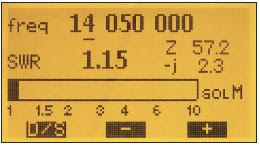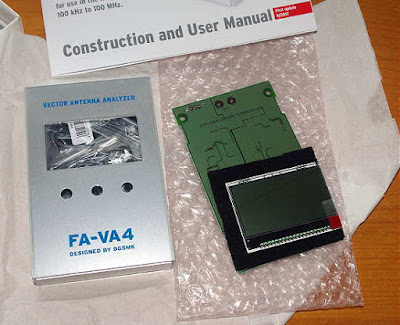 The FA-VA4 Vector Antenna Analyzer (LF-100MHz)
The FA-VA4 Vector Antenna Analyzer (LF-100MHz)

For some time I had been considering the purchase of the MFJ259 antenna analyzer but after a little online sleuthing, came across this little beauty, the FA-VA4 Antenna Analyzer by Funk Amateur in Germany and available through their Box73 website here.
I liked the fact that the cost of the analyzer was about half that of anything else comparable ($140 US including shipping) and that it covered the new 2200 / 630m bands!
I think many amateurs planning on building a system for either of these new bands will find the very affordable FA-VA4 a handy piece of equipment when it comes to working on their LF / MF antenna since most available SWR meters do not cover these frequencies accurately.
Delivery time was fast and everything was very well packaged. The FA-VA4 comes in partial kit form and requires only a short amount of time to put together.
The necessary assembly consists of soldering pin strip connectors, switches, AA cell holders, and the BNC connector. All of the tricky SMD components have been pre-mounted ... total assembly time was less than 60 minutes and everything fired-up nicely, without problems, thanks to the well written instruction / user manual.
Included with the kit are three BNC connectors needed to calibrate the instrument for the highest accuracy. These consist of a 'Shorted' connector, an 'Open' connector and a 50 ohm 'Load' connector (SOL). A simple three-part calibration procedure for all frequencies takes about 15 minute to complete, while the instrument calibrates itself as it scans through all frequency ranges with each connector plugged into the output. Once this task is completed, the analyzer is ready for use.
If you're like me, I think the main use will be to check out and tweak some of your HF antennas using the SWR or Z sweep function. This allows you to set a desired 'center' frequency along with a + / - sweep range and have the display draw a nice plot of your system.
Had my 630m antenna not already been tuned and matched, I would have found the analyzer to be a great help but, thanks to my 'scopematch', that antenna has already been optimised.
All menu features and data entry is via three momentary-contact push switches. Although this might initially seem awkward, it is not, and operation is pretty intuitive.
The main modes of operation are:
Single Frequency SWR Measurement
 |
| courtesy: http://www.box73.com/product/5 |
Single Frequency Impedance Measurement
 |
| courtesy: http://www.box73.com/product/5 |
Single SWR Measurement Run
 |
| courtesy: http://www.box73.com/product/5 |
Single Run For Impedance Measurement (Resistance and Reactance)
 |
| courtesy: http://www.box73.com/product/5 |
SWR Measurement On Five Frequencies (5 Band Measurement)
 |
| courtesy: http://www.box73.com/product/5 |
As well, all of the above can be viewed in a continuous 'cycle' mode, as inputs are changed and all screens can be saved for future reference.
Additional capabilities include use in an HF Signal Generator Mode (~ 1V square wave @50 ohms), the ability to measure C and L at a given frequency, as a 'dip meter' and to measure cable resonances and determine lengths.
The complete manual may also be downloaded from their website here.
I will soon put all of my antennas to the test and see what work might need to be done to optimize them, particularly my HF half slopers, which, in spite of their great performance, have always proven a bit of a mystery when it comes to pruning them to resonance ... I rather suspect that the sloping wires are more of an impedance tuning stub than a radiator and that most radiation comes from the vertical support tower, not the sloping wire.
All-in-all, the FA-VA4 appears to offer very good value for the money and is a well built, quality test instrument. I think it will become a popular choice among hams, especially those on LF / MF. The only thing different that I would have liked, would be to have a UHF (SO 239) connector rather than a BNC on the output, since most amateurs are using these on their HF systems ... or, the inclusion of a BNC-to-UHF adapter.
If you already use this device, please feel free to add your comments below!

















How does the unit deal with AM BC signals while measuring a relatively large antenna on 630 meters? My MFJ 259B is rather useless without a high-pass filter when measuring my 160-meter Marconi T antenna. I have to use my GR 916A, a signal generator and a null receiver (Icom R70) I like the idea of this unit covering 630m and 2200m, but unless one has a really good low pass filter, I wonder if it can cope with the incidental commercial broadcast RF. There is a 5KW station in my area on 560 kHz.
I don’t think you can compare the MFJ259 to this analyzer. I have a 259 and it did cost me a lot of money, but it dose a lot more than this analyzer can
I built one of these a few weeks ago in about an hour. It’s very easy to do as long as you have a fine soldering iron tip. Comparing this to my MFJ-259B is unfair as the MFJ has been with me for years, works flawlessly, and I don’t want to hurt it’s feelings.
All I had to do was make up a BNC to SO-239 jumper and the FA-VA4 can test anything I have with very high accuracy.
I’m so glad I got this analyzer especially for portable operating as it’s small, lightweight, easy to use, and uses only 2 AA alkalines. It won’t do as much as the 259 does but I rarely used the 259 for other than checking baluns, and SWR’s. If you are not inclined to build a kit get one and have someone build it for you. It’s a great piece of equipment.
Andy, I am not making a comparison with the MFJ which no doubt, is a very capable and versatile analyzer. Its popularity speaks volumes. What I’m saying is that for my purposes and possibly many others, this inexpensive analyzer will do everything that I am interested in. The added benefit is that it covers the LF and MF ranges as well.
As for Rob’s concern about its ability to deal with strong BCB signals that might interfere with antenna measurements, I cannot say. It was able to work well with my 630m inverted-L with no difficulties. Although there are no nearby BCB transmitters here on Mayne Island, I am directly across Georgia Strait from several 50kW signals in Vancouver and Washington state. A good number of these are exceptionally strong when looked at with the 756PROIII, being S9+30db or higher. Maybe someone using the analyzer can comment on this aspect.